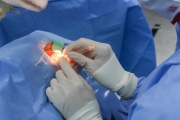Contents |
Clear Lense Extraction
Introduction
Clear Lens Extraction is another option to consider if you have been told you should not have LASIK due to high myopia (nearsightedness) or hyperopia (farsightedness), or other factors that make LASIK unsuitable for you, such as dry eyes.
Clear Lens Extraction (CLE) is the same surgery that is done to remove cataracts once the natural lens has become cloudy and interferes with vision; the only difference is that the natural lens, instead of being foggy and clouded as it is in cataracts, is still clear. CLE is a form of refractive surgery, and might be thought of in the same way as LASIK, just using a different surgical technique to get to the same place.
People with nearsightedness or farsightedness of more than five diopters (A diopters is the unit of measurement for ophthalmic lenses, which describes its focal length; the focal length of a lens is a direct measure of how strong the lens is.) are usually not considered to be good candidates for LASIK, because it would leave the cornea too thin afterwards. Dry eyes can be made worse with LASIK because it disturbs the outer layer of cells on the front of the eye.
When the crystalline lens inside the eye is removed, it is replaced with an artificial intraocular lens (IOL), which is chosen by the surgeon based on measurements of the eye and existing refractive error at the time of surgery. A person who has cataract surgery gets an added benefit, that of not being as dependent on glasses or contact lenses as they had been before they had their cataracts removed; CLE makes use of that benefit to reduce refractive error instead of removing cataracts. The side benefit now becomes the primary reason for the procedure.
In fact, it is not possible for CLE patients to develop cataracts later; the lens inside the eye where they form is no longer present.
As in LASIK, most patients who have CLE won’t need to wear corrective lenses for distance vision at all, although reading glasses for close work like reading or using a computer may be needed. Most people after cataract extraction or CLE will be able to drive without corrective lenses. (Recently, there have been improvements in technology with multifocal IOLs, which will help minimize the need for reading glasses; discuss this option with your surgeon.)
Patients considering any type of refractive surgery should discuss all their options with their eyecare practitioner and make sure they completely understand what each method or procedure will do and what it won’t do.
Patients considering CLE should know that most insurance carriers, including Health Canada or Medicare in the US, do not cover the cost of CLE, but do pay for cataract extraction surgery; the difference is whether the natural lens has a visually significant loss of transparency (a cataract) before the surgery.
What to Expect in CLE
Your eyecare practitioner will help you determine if CLE is right for you, and do thorough testing to get the information about you and your vision that the surgeon will need. Benefits and risks of complications will be discussed and any questions you have will be addressed. This comprehensive vision exam will include a review of your health, your eye history and a variety of ophthalmic tests including ultrasonic testing to determine the length of your eye and the required power the IOL will have for your individual needs.
If you are a contact lens wearer, you will need to discontinue wearing them before your pre-surgical examination; soft lenses must be out of the eyes for at least two days, and patients with gas-permeable contact lenses will need to leave their lenses out for a minimum of one week, more if possible. This is because even soft lenses and optimally-fitted rigid lenses do cause the cornea to change its shape slightly and it will need time to revert back to its natural curves and structure.
CLE is done one eye at a time, with at least one week between the first and second eye, just as in cataract extraction surgery.
The Procedure
On arrival at the surgical center on the day of your procedure, you will be able to ask any questions you may still have before the surgery begins. Additional testing, if needed, will be done at this time.You will then be asked to read and sign a surgical consent form and ask about any information pertaining to it as well.
A technician will go over your post-operative instructions and make sure you understand them.
Dress casually and comfortably; do not wear any makeup or skin creams prior to your arrival. You will need to bring a companion who can drive you home following your procedure.
You will be given a light sedative to help you relax, then, a series of eye drops will be administered to numb the eye. Allergic reactions to these medications are rare, but please advise the surgeon or technician about any allergies you may have.
Prior to entering the surgical suite you will be asked to place a surgical gown over your street clothes, and will then be shown into the suite where you will be seated in a chair and reclined into position. At that time, a surgical drape will be placed which will only expose the eye being operated on. The procedure is performed under topical anesthetic, so you will be awake and aware for the duration.
A surgical instrument called an eyelid speculum will be placed between your upper and lower lids to prevent you from blinking while the procedure is underway.
A small incision will be made in sclera (the white of the eye), near the edge of the cornea (the clear, dome-shaped structure covering the iris) and the natural lens will be broken into tiny pieces with an ultrasonic tool; this is called phakoemulsification. Once the lens has been broken apart, it can then be removed from its capsule by a suction device. The capsule itself is polished and left in place to help position and support the implant lens when it is inserted into the eye using a specialized instrument. The incision is then closed and if any sutures are required they will be placed; your procedure is now complete.
Most procedures are complete in about 15 minutes.
After the Procedure
You should plan to rest for the remainder of the day and use the eye drops as instructed; before you leave the surgical center you will be given a kit containing all of the required eye drops along with written instructions for their use. Your medication kit will also contain an oral medication for pain, to be used if needed.
You may experience some light sensitivity or mild irritation and your vision may be blurry. This is normal and, in fact, your vision may fluctuate during the first month or so following CLE.
During the first few nights, you will be asked to wear an eye patch while sleeping, to protect your eye from accidental injuries.
To ensure that the healing process is progressing normally, you will have several follow-up visits after your CLE, starting with one the next day, then the following week, and so on, until your eye is completely healed and your vision is no longer fluctuating.
Showering and bathing are fine, but avoid getting water or soap in your eye; avoid swimming, hot tubs and saunas for at least two weeks after your procedure. Also, avoid activities that require bending over or lifting, like gardening for example, and be careful not to rub your eye for at least a month. It is best to leave your makeup off for at least two weeks, especially mascara, eyeliner, eye shadow and any cosmetic containing flakes of glitter or metallic particles.
Unless there are unexpected complications, you will be seen for follow-up after the one-day visit at one week, one month, and three months. You may return to the surgical center for these visits or to your optometric physician, which may be more convenient.
Most patients find that they can return to work after their one-day post-op check, but some may want to wait another day.
Summing Up
Refractive surgery is a wonder of our modern world, and clear lens extraction is a benefit of newer and safer methodology that has come out of advances in surgery to remove cataracts. Because cataract extraction is considered to be one of the safest procedures being done, with the best outcomes being the usual case rather than the exception, surgeons are more willing to use the same procedure without waiting for the cataract to develop, instead using what is usually a side benefit and making it the primary reason for the surgery.
Most patients undergoing CLE have an uneventful recovery and find that their vision is much better without correction than it was before, and that, after all, is why you underwent the procedure to start with. You may find you need glasses for reading, or if you have opted for a multifocal IOL, that you can see satisfactorily at all distances; this usually takes a little time for adaptation, but once that happens, your vision should be better than ever.
No refractive surgery, including CLE and LASIK, will allow you to “throw your glasses away and never have to see your eye doctor again.” Patients must remember that these surgeries involve the front part of the eye, and not the structures in the posterior half of the eye, including the optic nerve head and the retina. Just because the front of the eye has changed does not mean you don’t still need regular vision exams, not necessarily for glasses or contact lenses, but to check the health of your eyes. A person who has CLE at age 30 can still develop systemic conditions like diabetes or eye disease such as glaucoma later in life. (The one thing that can’t happen later is cataracts, because the natural lens is gone.) Certainly these can profoundly affect the retina and related structures. Don’t be in too big a rush to say goodbye to your eyecare practitioner, because you will still need one.Having reasonable expectations is important, and allowing yourself time to adapt to your new visual condition. Outcomes vary, as with any type of surgery, and this type of refractive surgery is somewhat more invasive than LASIK, because it involves an incision and going into the eye to remove the natural lens and replace it with the IOL. Because of that, it is extremely important to follow all instructions exactly to minimize the chance of complications.
Don’t forget, however, to enjoy your new clear vision.








